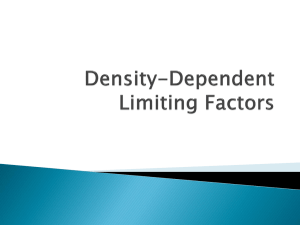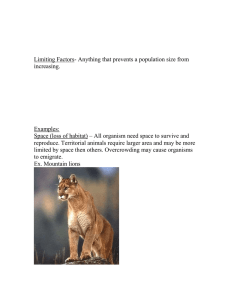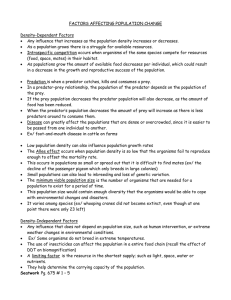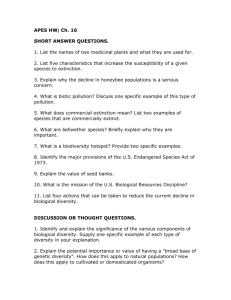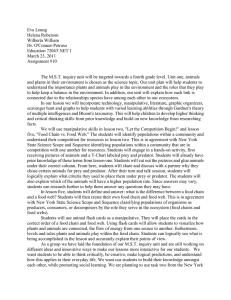Population Growth Finz 2012
advertisement
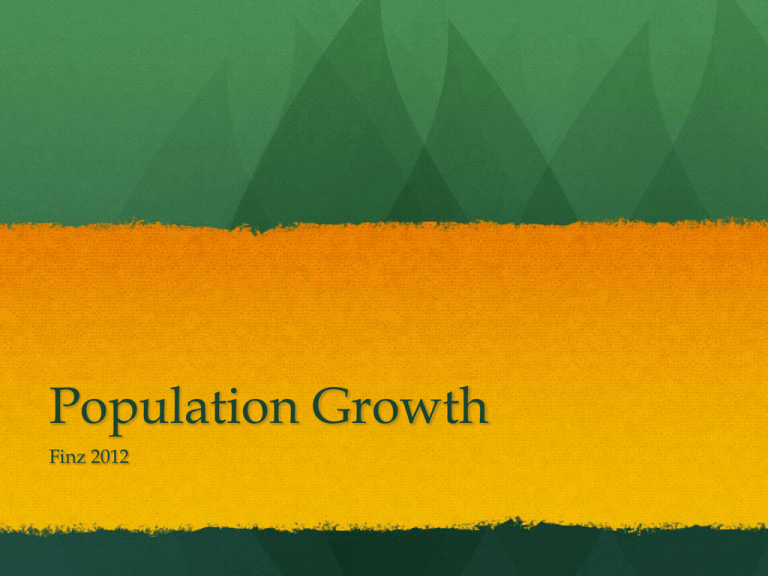
Population Growth Finz 2012 What is a population? A population is a group of individuals of the same species living in the same geographic area. The study of factors that affect growth, stability, and decline of populations is population dynamics. All populations undergo three distinct phases of their life cycle: What 3 phases do populations go through? growth stability decline What is meant by population growth? Population growth occurs when available resources exceed the number of individuals able to exploit them. Reproduction is rapid, and death rates are low, producing a net increase in the population size. What is population stability? Population stability is often preceded by a "crash" since the growing population eventually outstrips its available resources. Stability is usually the longest phase of a population's life cycle. What is population decline? Decline is the decrease in the number of individuals in a population, and eventually leads to population extinction. Factors that influence population growth Nearly all populations will tend to grow exponentially as long as there are resources available. Most populations have the potential to expand at an exponential rate, since reproduction is generally a multiplicative process. Two of the most basic factors that affect the rate of population growth are the birth rate, and the death rate. The intrinsic rate of increase is the birth rate minus the death rate. Modes of population growth Two modes of population growth The Exponential curve (also known as a J-curve) occurs when there is no limit to population size. The Logistic curve (also known as an S-curve) shows the effect of a limiting factor (in this case the carrying capacity of the environment). Population Growth Potential Is Related to Life History The age within its individual life cycle at which an organism reproduces affects the rate of population increase. Life history refers to the age of sexual maturity, age of death, and other events in that individual's lifetime that influence reproductive traits. Population Growth Potential Is Related to Life History Some organisms grow fast, reproduce quickly, and have abundant offspring each reproductive cycle. Other organisms grow slowly, reproduce at a late age, and have few offspring per cycle. Most organisms are intermediate to these two extremes. Population Growth Potential Is Related to Life History Age structure refers to the relative proportion of individuals in each age group of a population. Populations with more individuals aged at or before reproductive age have a pyramidshaped age structure graph, and can expand rapidly as the young mature and breed. Stable populations have relatively the same numbers in each of the age classes. Comparison of the population age in the United States & Mexico Comparison of the population age in the United States & Mexico Where is the human population at population stages? Human populations are in a growth phase. Since evolving about 200,000 years ago, our species has proliferated and spread over the Earth. Beginning in 1650, the slow population increases of our species exponentially increased. Where is the human population at population stages? New technologies for hunting and farming have enabled this expansion. It took 1800 years to reach a total population of 1 billion, but only 130 years to reach 2 billion, and a mere 45 years to reach 4 billion. Where is the human population at population stages? Despite technological advances, factors influencing population growth will eventually limit expansion of human population. These will involve limitation of physical and biological resources as world population increased to over six billion in 1999. The world population has reached over 7 billion people in October 2011! Human population growth over the past 10,000 years Human population growth over the past 10,000 years Populations Transition between Growth and Stability Limits on population growth can include food supply, space, and complex interactions with other physical and biological factors (including other species). Populations Transition between Growth and Stability After an initial period of exponential growth, a population will encounter a limiting factor that will cause the exponential growth to stop. Populations Transition between Growth and Stability The population enters a slower growth phase and may eventually stabilize at a fairly constant population size within some range of fluctuation. Populations Transition between Growth and Stability This model fits the logistic growth model. The carrying capacity is the point where population size levels off. Carrying Capacity Several Basic Controls Govern Population Size The environment is the ultimate cause of population stabilization. Two categories of factors are commonly used: physical environment and biological environment. Several Basic Controls Govern Population Size Three subdivisions of the biological environment are competition, predation, and symbiosis. Several Basic Controls Govern Population Size Physical environment factors include food, shelter, water supply, space availability, and (for plants) soil and light. One of these factors may severely limit population size, even if the others are not as constrained. Several Basic Controls Govern Population Size The biological role played by a species in the environment is called a niche. Niche Overlap Organisms/populations in competition have a niche overlap of a scarce resource for which they compete. Competitive exclusion occurs between two species when competition is so intense that one species completely eliminates the second species from an area. Niche Overlap In nature this is rather rare. While owls and foxes may compete for a common food source, there are alternate sources of food available. Niche overlap is said to be minimal. Predators – Important? Predators kill and consume other organisms. Carnivores prey on animals, herbivores consume plants. Predators usually limit the prey population, although in extreme cases they can drive the prey to extinction. Predators – Important? There are three major reasons why predators rarely kill and eat all the prey: Prey species often evolve protective mechanisms such as camouflage, poisons, spines, or large size to deter predation. Prey species often have refuges where the predators cannot reach them. Often the predator will switch its prey as the prey species becomes lower in abundance: prey switching. Moose and Wolf Fluctuations in predator (wolf) and prey (moose) populations over a 40-year span. Note the effects of declines in the wolf population in the late 1960s and again in the early 1980s on the moose population. Symbiosis Symbiosis has come to include all species interactions besides predation and competition. Mutualism is a symbiosis where both parties benefit. Can you think of any examples? Parasitism Parasitism is a symbiosis where one species benefits while harming the other. Parasites act more slowly than predators and often do not kill their host. Zombie Ant Brood Parasitism Commensalism Commensalism is a symbiosis where one species benefits and the other is neither harmed nor gains a benefit: Spanish moss on trees, barnacles on crab shells. Population Decline and Extinction Extinction is the elimination of all individuals in a group. Local extinction is the loss of all individuals in a population. Species extinction occurs when all members of a species and its component populations go extinct. Population Decline and Extinction The ultimate cause of decline and extinction is environmental change. Changes in one of the physical factors of the environment may cause the decline and extinction; likewise the fossil record indicates that some extinctions are caused by migration of a competitor. Human Population Decline Dramatic declines in human population happen periodically in response to an infectious disease. Bubonic plague infections killed half of Europe's population between 1346 and 1350, later plagues until 1700 killed one quarter of the European populace. Smallpox and other diseases decimated indigenous populations in North and South America. Human Impact Human populations have continued to increase, due to use of technology that has disrupted natural populations. Destabilization of populations leads to possible outcomes: population growth as previous limits are removed population decline as new limits are imposed Human Impact Agriculture and animal domestication are examples of population increase of favored organisms. In England alone more than 300,000 cats are put to sleep per year, yet before their domestication, the wild cat ancestors were rare and probably occupied only a small area in the Middle East. Pollution Impact Pollutants generally are releases of substances into the air and water. Many lakes often have nitrogen and phosphorous as limiting nutrients for aquatic and terrestrial plants. Runoff from agricultural fertilizers increases these nutrients, leading to runaway plant growth. Increased plant populations eventually lead to increased bacterial populations that reduce oxygen levels in the water, causing fish and other organisms to suffocate. Pesticides and Competition Removal of a competing species can cause the ecological release of a population explosion in that species competitor. Pesticides sprayed on wheat fields often result in a secondary pest outbreak as more-tolerant-to-pesticide species expand once less tolerant competitors are removed. Removal of Predators Predator release is common where humans hunt, trap, or otherwise reduce predator populations, allowing the prey population to increase. Elimination of wolves and panthers has led to increase in their natural prey: deer. There are more deer estimated in the United States than there was when Europeans arrived. Large deer populations often cause over grazing that in turn leads to starvation of the deer. Introduction of New Species Introduction of exotic or alien non-native species into new areas is perhaps the greatest single factor to affect natural populations. More than 1500 exotic insect species and more than 25 families of alien fish have been introduced into North America; in excess of 3000 plant species have also been introduced. Introduction of New Species The majority of accidental introductions may fail, however, once an introduced species becomes established, its population growth is explosive. Kudzu, a plant introduced to the American south from Japan, has taken over large areas of the countryside. Kudzu covering a building (left) and close-up of the flowers and leaves (right). Altering Population Growth Humans can remove or alter the constraints on population sizes, with both good and bad consequences. On the negative side, about 17% of the 1500 introduced insect species require the use of pesticides to control them. Altering Population Growth For example, African killer bees are expanding their population and migrating from northward from South America. These killer bees are much more aggressive than the natives, and destroy native honeybee populations. Altering Population Growth On a positive note, human-induced population explosions can provide needed resources for growing human populations. Agriculture now produces more food per acre, allowing and sustaining increased human population size. Habitat Habitat disruption is the disturbance of the physical environment of a species, for example cutting a forest or draining wetlands. Habitat disruption is currently the leading cause of extinction. Changes in the biological environment occur in three ways. Species introduction: An exotic species is introduced into an area where it may have no predators to control its population size, or where it can greatly out compete native organisms. Examples include zebra mussels introduced into Lake Erie, and lake trout released into Yellowstone Lake where they are threatening the native cutthroat trout populations. Changes in the biological environment occur in three ways. Over hunting: When a predator population increases or becomes more efficient at killing the prey, the prey population may decline or go extinct. Examples today include big game hunting, which has in many places reduced the predator (or in this case prey) population. In human prehistory we may have caused the extinction of the mammoths and mastodons due to increased human hunting skill. Changes in the biological environment occur in three ways. Secondary extinction: Loss of food species can cause migration or extinction of any species that depends largely or solely on that species as a food source. Species Loss Overkill is the shooting, trapping, or hunting of a species usually for sport or economic reasons. However, many large animals have been eliminated or had their populations drastically reduced (such as tigers, elephants, and leopards). Species Loss The death of one species or population can cause the decline or elimination of others, a process known as secondary extinction. Species Loss Destruction of bamboo forests in China, the food for the giant panda, may cause the extinction of the panda. The extinction of the dodo bird has caused the Calviera tree to become unable to reproduce since the dodo ate the fruit and processed the seeds of that tree. Giant pandas eat an estimated 10,000 pounds of bamboo per panda per year. Range and Density Populations tend to have a maximum density near the center of their geographic range. Geographic range is the total area occupied by the species. Outlying zones, where conditions are less optimal, include the zone of physiological stress (where individuals are rare), and eventually the zone of intolerance (where individuals are not found). Range and Density The environment is usually never uniform enough to support uniform distribution of a species. Species thus have a dispersion pattern. Three patterns found include uniform, clumped, and random. Range and Density Geographic ranges of species are dynamic; over time they can contract or expand due to environmental change or human activity. Often a species will require another species' presence, for example Drosophila in Hawaii. Species ranges can also expand due to human actions: brown trout are now found worldwide because of the spread of trout fishing.
